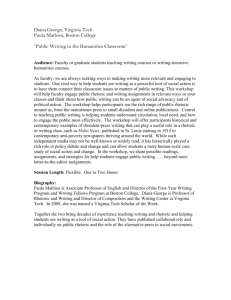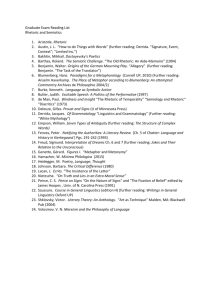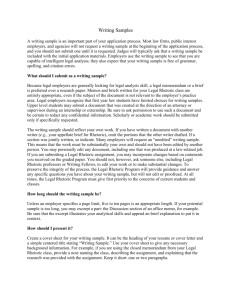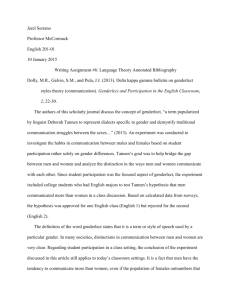Communication Theory Test 3 - Key Names and Terms The test will
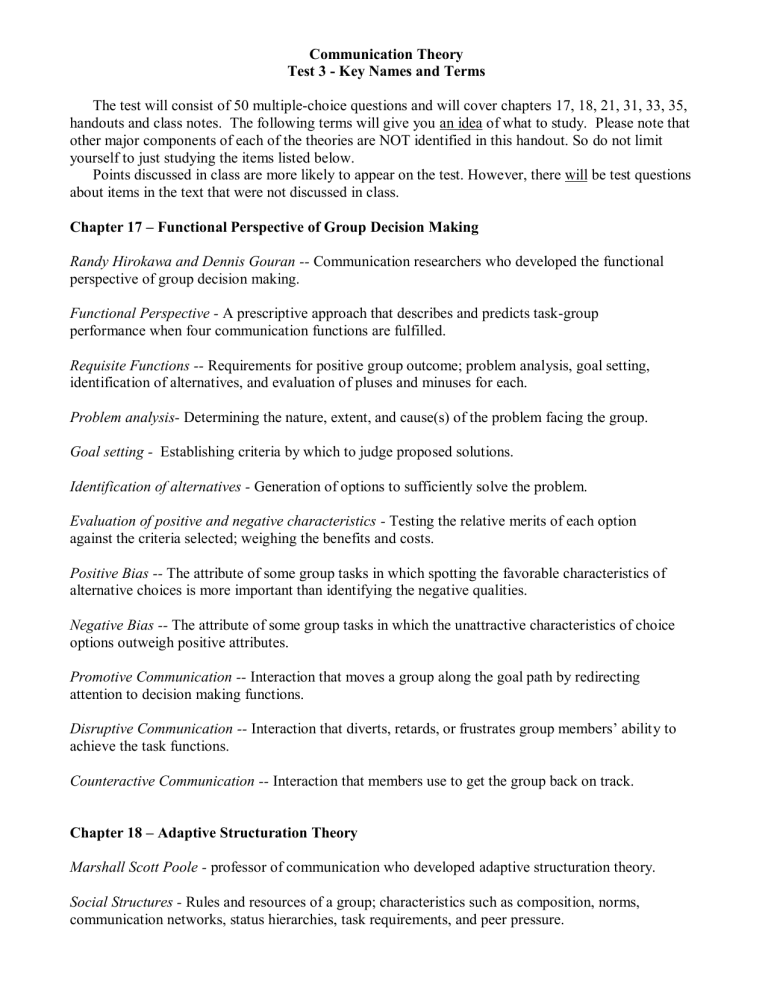
Communication Theory
Test 3 - Key Names and Terms
The test will consist of 50 multiple-choice questions and will cover chapters 17, 18, 21, 31, 33, 35, handouts and class notes. The following terms will give you an idea of what to study. Please note that other major components of each of the theories are NOT identified in this handout. So do not limit yourself to just studying the items listed below.
Points discussed in class are more likely to appear on the test. However, there will be test questions about items in the text that were not discussed in class.
Chapter 17 – Functional Perspective of Group Decision Making
Randy Hirokawa and Dennis Gouran -- Communication researchers who developed the functional perspective of group decision making.
Functional Perspective - A prescriptive approach that describes and predicts task-group performance when four communication functions are fulfilled.
Requisite Functions -- Requirements for positive group outcome; problem analysis, goal setting, identification of alternatives, and evaluation of pluses and minuses for each.
Problem analysis- Determining the nature, extent, and cause(s) of the problem facing the group.
Goal setting - Establishing criteria by which to judge proposed solutions.
Identification of alternatives - Generation of options to sufficiently solve the problem.
Evaluation of positive and negative characteristics - Testing the relative merits of each option against the criteria selected; weighing the benefits and costs.
Positive Bias -- The attribute of some group tasks in which spotting the favorable characteristics of alternative choices is more important than identifying the negative qualities.
Negative Bias -- The attribute of some group tasks in which the unattractive characteristics of choice options outweigh positive attributes.
Promotive Communication -- Interaction that moves a group along the goal path by redirecting attention to decision making functions.
Disruptive Communication -- Interaction that diverts, retards, or frustrates group members’ ability to achieve the task functions.
Counteractive Communication -- Interaction that members use to get the group back on track.
Chapter 18 – Adaptive Structuration Theory
Marshall Scott Poole - professor of communication who developed adaptive structuration theory.
Social Structures - Rules and resources of a group; characteristics such as composition, norms, communication networks, status hierarchies, task requirements, and peer pressure.
Structuration - The production and reproduction of social systems through group members’ use of rules and resources in interaction.
Interaction - Intentional acts of group members who are aware of what they are doing.
Rules - Propositions that indicate how things ought to be done or what is good or bad; recipes for actions.
Resources - Materials, possessions, or attributes that can be used to influence or control the actions of the group or its members.
Appropriation - Adopting a rule or resource from another group or the larger culture.
Production - The use of rules and resources to create a new structure; change.
Reproduction - The use of rules and resources to reinforce structures already in place.
Duality of structure - The idea that rules and resources are both the means and the ends of group interaction.
Chapter 21 – The Rhetoric of Aristotle
Rhetoric - Defined by Aristotle as the art of seeing, in each particular case, all the available means of persuasion.
Public Rhetoric - A speaking context in which the speaker has an opportunity to monitor and adjust to the response of his or her immediate audience.
Canons of Rhetoric -- the principal divisions of the art of persuasion established by ancient rhetoricians: invention, arrangement, style, delivery, and memory.
Invention- The aspect of rhetoric concerned with discovering convincing arguments.
Arrangement - The aspect of rhetoric concerned with organizing material for best impact.
Style - The aspect of rhetoric concerned with selecting appropriate language.
Delivery - The aspect of rhetoric concerned with coordinating voice and gesture.
Memory - The aspect of rhetoric concerned with mastering and rehearsing content.
Aristotle -- An ancient Greek teacher and scholar whose Rhetoric represents the first systematic study of public speaking.
Logos -- Logical proof, which comes from the line of argument in the speech.
Ethos -- Ethical proof, which comes from the speaker's intelligence, character, and goodwill toward the audience as these personal characteristics are revealed through the message.
Enthymeme -- An incomplete version of a formal deductive syllogism that is created by leaving out a premise that is already accepted by the audience or omitting an obvious conclusion.
Pathos -- Emotional proof, which comes from the feeling the speech draws from the hearers.
Chapter 31 – Face-Negotiation Theory
Face --
The projected image of one’s self in a relational situation
Facework -- Specific verbal and nonverbal messages that help to maintain and restore face loss, and to uphold and hold face gain.
Collectivistic Culture - Wherein people identify with a larger group that is responsible for providing care in exchange for group loyalty; we-identity; a high-context culture
Individualistic Culture -- Wherein people look out for themselves; I-identity; a low-context culture
Self-construal -- Self-image; the degree to which people conceive of themselves as relatively autonomous from, or connected to, others.
Face-concern - Regard for self-face, other face, or mutual face
Face-Restoration -- The self-concerned facework strategy used to preserve autonomy and defend against personal loss of freedom.
Face-Giving -- The other-concerned facework strategy used to defend and support another person’s need for inclusion.
Emotional Expression -- Managing conflict by disclosure of venting of feelings
Passive Aggression -- Making indirect accusations, showing resentment, procrastination, and other behaviors aimed at thwarting another’s resolution of conflict
Third-Party Help -- A method of conflict management whereby disputing parties seek the aid of a mediator, arbitrator, or respected neutral third party to help them resolve their differences.
Avoiding -- Responding to conflict by withdrawing from open discussion
Obliging -- Accommodating or giving into the wishes of the other in a conflict situation
Compromising -- Conflict management by negotiation or bargaining; seeking a middle way
Dominating --
Competing to win when people’s interests conflict
Integrating -- Problem solving through open discussion; collaboration; a win-win resolution of conflict
Independent Self - The self-construal of individuals who conceive of themselves as relatively autonomous from others; I-identity.
Interdependent Self - The self-construal of individuals who conceive of themselves as interconnected with many others; we-identity.
Note – Also check out pages 384-386 to give you some background of Intercultural
Communication. Some terms discussed in these pages include:
High-context culture – A culture in which most information is located in the physical context or internalized in the person, but very little is in the coded, explicit part of the message; a collectivist culture.
Low context culture – A culture in which most of the information communicated is located in the explicit code of the message rather than the physical context or the internalized in the person.
Chapter 33 – Genderlect Styles - also read pages 426 -428
Gender - A social construction of the characteristics of men and women that are often labeled as masculine and feminine; sex is a fact, while gender is an idea that has been learned from and reinforced by others.
Deborah Tannen- A linguist at Georgetown University who pioneered research in genderlect styles.
Genderlect -- A term that suggests that masculine and feminine styles of discourse are best viewed as two distinct cultural dialects and not inferior or superior ways of speaking.
You Just Don't Understand -- Tannen's best-seller, presents genderlects styles to a popular audience.
Rapport Talk -- The conversational style Tannen associates with women, which seeks to establish connection with others.
Report Talk -- The conversational style Tannen associates with men, which seeks to command attention, convey information, and insist win arguments.
Tag Question -- A short question at the end of a declarative statement, often used by women to soften the sting of potential disagreement and to invite participation in open, friendly dialogue.
Aha Factor --
A subjective standard ascribing validity to an idea when it resonates with one’s personal experience.
Chapter 35 – Muted Group Theory
Cheris Kramarae -- leader in the study of muted group theory.
Muted Group Theory -- An approach to communication that considers women a muted group because manmade language aids in defining, depreciating, and excluding them.
The masculine power to name experience. - Kramarae’s basic assumption is that women perceive the world differently from men because of women’s and men’s different experiences and activities rooted in the division of labor.
Sexual Harassment -- The unwanted imposition of sexual requirements in the context of a relationship of unequal power.

